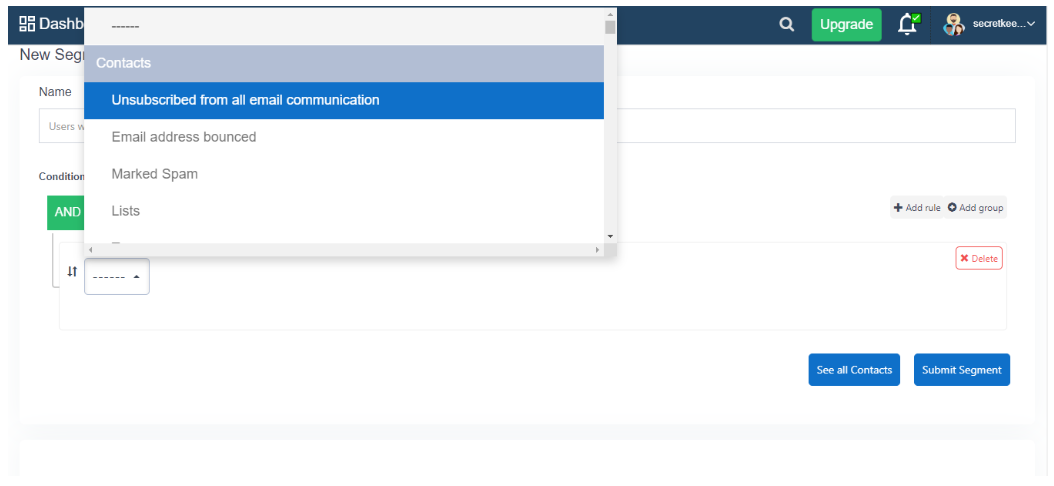Unsubscribe Rate – Is it good or bad? What if I say it is both good and bad. On the brighter side, it helps you clean your list. On the darker side, it is painful to see the contacts moving out, leaving you to ponder what you could’ve done to save those unsub scribers.
Table of Contents
What is Unsubscribe Rate?
An unsubscribe rate shows you the percentage of users who have opted out from your mailing list after an email campaign. This tells you the number of subscribers who have chosen not to receive your newsletter any further.
The higher the unsubscribe rate, the lower your email deliverability and domain reputation, leading to ISPs or email service providers like Gmail and Yahoo marking you as spam. A spike in this number helps you understand which campaigns are working and which aren’t.
How to Calculate Unsubscribe Rate?
An unsubscribe rate is the number of unsubscribes divided by the number of emails delivered.
Unsubscribe rate calculation:

For example, if 3000 emails are delivered in your email campaign and 20 subscribers have opted out, then your unsubscribe rate is 0.6%.
A good unsubscribe rate is 0.5%. However, this varies according to your industry. Do check here for unsubscribe rates across various sectors.

Well, how will you know when someone clicks on the unsubscribe button in your email? ESPs like SendX help you track your unsubscribe rate over a period of time or across campaigns.
This helps you perform audience analysis – what did your subscribers like or dislike about it? What interests them? What is the pattern of your unsubscribe rate? Did it increase because of the email format, or maybe an irrelevant subject line triggered it?
Tracking your unsubscribe rate from time to time is not just critical but essential, as it helps you realign your email marketing strategy.
What is a Good Unsubscribe Rate?
According to a report published by SmartInsights in 2020 about unsubscribe rates across industries, the range of unsubscribe rates is 0.2–0.1%.
So, if you are looking for a number against which you can benchmark your unsubscribe rate, choose 0.15%. If the unsubscribed rate is below this, you don't have to take any specific steps. If you see it rising, you should audit your email marketing activities and see which emails people unsubscribe from, and what kind of audience is unsubscribing the most.
Eventually, you will find a pattern in unsubscribed and form your own good or bad unsubscribe rate.
Why is My Unsubscribe Rate so High?
If your unsubscribe rate is above 1% (or in double digits—ouch!) it can be because of the following factors:
Mismatch in expectations
People's expectations from the emails are different from what you are delivering. This can happen if your messaging on the signup form is not coherent with the content you are delivering. For example, if you promised your audience marketing content but then your content is more suited for sales than marketing, people would unsubscribe.
Formatting of content
If your content is exactly what the audience wants but it’s delivered in a manner that’s not easy to read, digest, or scan through, people won’t get the desired value out of it and will unsubscribe.
No or incorrect segmentation
Your email campaigns should only be sent to people who would find them relevant. To ensure that, you should create categories of your audience based on demographics, purchase history, and engagement rate.
For example, an email announcing a sale in the women's section should be sent to women only. Most men would not find it relevant (some might want to shop for a woman, but those are exceptional cases). If it’s sent to men, they will likely unsubscribe, thinking it’s not a relevant brand for them.
Ways to Reduce Unsubscribe Rate
Segment your email list
Segmenting your audience from time to time can help you send content that is relevant to them, reducing the number of unsubscribes. Follow the best practices mentioned here if you have an email list of 100k or more. If you have a smaller list, check out our ultimate small business marketing guide.
For example, if you have an eCommerce store, you can segment your audience based on location, gender, average order value, purchase frequency, holiday buyers, high-return customers, or traffic source.
Then, if you are launching a new collection in, let's say, the city of Paris, you can create a segment that satisfies two conditions: (1) location of the contact is Paris and (2) they are among your top spenders on your website.
Then you can invite them for an exclusive sneak peek or send special coupons to generate a buzz.
Understand the goals of your email marketing
Users stick around only if you provide valuable and relevant information. Determine the goals of your campaign and build engaging content that interests your readers. Check out our “5 Email Copywriting Tips” for creating engaging content.
Follow the art of personalization
Too many emails from the same brand can be annoying at times. Understand what your subscriber needs and send them only that. Check this guide to bulk email blasts
Personalisation means more than just using the first name of the subscriber. It means sending the right emails to the right audience at the right time. So for example, if someone signed for your webinar on 'how to read faster', you send them 2-3 emails related to that. You also send reminder emails to attend the webinar. This will not only make them feel special but also engaged. Hence, building trust in your brand leading to lower Unsubscribe rate.
Remember, unsubscribe are part of the game and you can’t completely avoid them. However, you can track them to analyze the success of your campaigns and make modifications accordingly.